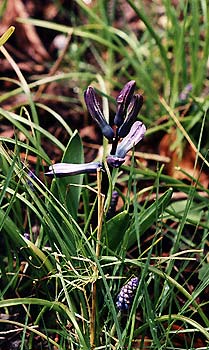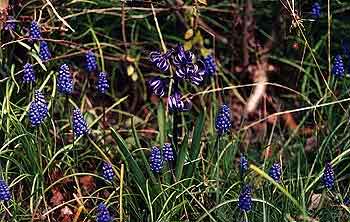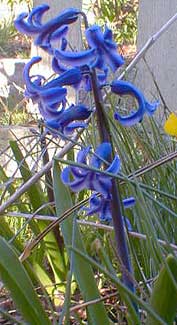 An Heirloom Bulb:
An Heirloom Bulb:
Roman Hyacinth
"The hyacinth my garden gave
Shall lie upon that Roman grave!"
-Oliver Wendell Holmes
1809-1894
1809-1894
Among all the bulbs that had naturalized throughout our gardens years or decades before ever we bought the house, there was one hyacinth that looked entirely different from the various squills that would pop up here & there.
Granny Artemis set out to identify it, & discovered that it is a wildflower of Southern France, Hyacinthus orientalis albulus. In the Victorian era it was a common garden variety, but it has been almost entirely displaced in the trade by fancy Dutch hyacinth cultivars. It has thus become a rare heirloom bulb.
 There's a hybrid version on the market called 'Fairy Hyacinth' which crosses the albulus variant with the more densely flowered Hyacinthus orientalis, plus Bellevalia romana is similarly called Roman Hyacinth or Roman Squill. But the real thing is extremely rare, henced offered rarely, & pricy during those brief moments it comes into the hands of bulb specialists.
There's a hybrid version on the market called 'Fairy Hyacinth' which crosses the albulus variant with the more densely flowered Hyacinthus orientalis, plus Bellevalia romana is similarly called Roman Hyacinth or Roman Squill. But the real thing is extremely rare, henced offered rarely, & pricy during those brief moments it comes into the hands of bulb specialists. It's sometimes called the French Hyacinth because of where it originates, but is more commonly called the Roman Hyacinth, because it is believed to have been cultivated by the ancient Greeks & Romans. The fertility daemon or godling Hyacinthus, lover of Zeus, may well have been a personification of this very flower.
It's sometimes called the French Hyacinth because of where it originates, but is more commonly called the Roman Hyacinth, because it is believed to have been cultivated by the ancient Greeks & Romans. The fertility daemon or godling Hyacinthus, lover of Zeus, may well have been a personification of this very flower.It blooms fragrantly in March at the tail-end of winter, about the same time or overlapping with early crocuses & grape hyacinths. When the crocuses fade, the grape hyacinth & this Roman Hyacinth lingers through April. The Roman seeds at the start of May, the Grapes in late May. A long bloom time overall.
The first photo above was taken about mid-March. The second photo, from March's end, shows the Roman Hyacinth in its fullest bloom. It's a much less densely flowered spike than other hyacinths, with a much more uneven, wild-looking appearance.
The comparativeoly weedy grape hyacinths increasingly crowded this single bulb, so a couple years after the first two photos were taken, I lifted the bulb & moved it to a sunnier spot amidst less aggressive bulbs. The third photo shows it with increased vigor the following March.
It is obviously not an aggressive plant as it never spread, & reproducing oriental hyacinth bulbs is a rather specialized endeavor not easily undertaken in the average garden. But the Roman Hyacinth is known to be hardier & longer-lived than bigger fancier hyacinths, so not surprising it would survive who knows how awfully long before we bought our house.